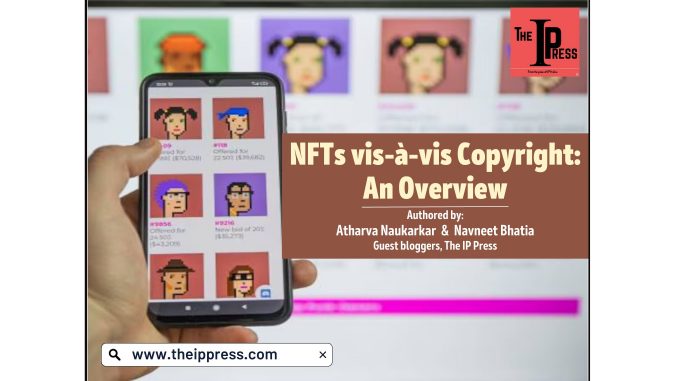
INTRODUCTION
The term “non-fungible token” refers to a token that is not fungible i.e. non-interchangeable unit of data stored on a blockchain, a form of digital ledger, which can be sold and traded. NFTs are tokens that can be used to represent ownership of unique goods. In economics, a transferable asset is anything where units can be easily interchanged – like money – or we may say NFTs are tokens that can be used to represent ownership of unique items. FTs are “one-of-a-kind” digital assets that may be purchased and traded just like any other piece of property, but they don’t require any physical form. Credentials of ownership for virtual or actual assets are frequently used to classify digital tokens[1].
NFTs AND COPYRIGHT: A RELATION
On fixation, the author of a copyrightable work holds the copyright to that work, similar to how NFTs are traded and interchanged between the parties. The copyright on creation belongs to the employer or commissioning party if it’s a piece for hire. If you’re not the creator of a piece and want the copyright for that employment outside of a work-for-hire context, you’ll need to get the rights transferred to you by the copyright owner. The transfer must be made in writing and must be explicit[2].
Copyrights can be divided virtually indefinitely by contract. The many exclusive rights of a copyright owner are frequently transferred and split by geographic area, among different parties, in multiple media, and so on, and each severable right might have its own duration and time, pricing, and payment terms. Artists might sell fractional ownership of any of their work’s exclusive rights to anyone. Keeping track of those divided rights that can be given, each of which can then be transferred, can be difficult and time-consuming.
NFTs may offer a way to automate this process, allowing the copyright owner of the initial work, or a divided right, to keep track of what needs to be sold and collected. If and when NFTs are used to transfer copyrights, block chain accounting will almost certainly come in handy in keeping track of all of those competing interests.
Acquiring ownership of an NFT representing a work in which copyright subsists does not, without more, grant the new owner of the NFT copyright in the underlying work.
NFTs are now deemed undividable since they cannot be divided into smaller values like other crypto currencies. However, we believe this will change in the future. An NFT might represent not just ownership of a complete copy of a piece, but also shared ownership of a reproduction in the future. In this fashion, a buyer of a high-end NFT of digital art may use the block chain to sell fractional shares of his NFT. Furthermore, the originator of an NFT may be paid a portion of the resale of not just the NFT he sold, but also any future individual investment in the NFT. For example, NFTs may be resold without restriction, and certain NFT markets are programmed to enforce Smart Contracts royalty “clauses,” which automatically pay a fee to the minter-seller[3] upon the sale of an NFT, generally as a percentage of the sales price[4].
Here, everyone must wait to see if NFTs become divisible, and if divisible copyright rights do transfer with certain NFTs, the block chain technology will have to keep track of an enormous number of conceivable rights[5], payments, and ownership interests. However, technology has before astonished us. In addition, when multiple rights holders have interests in the same copyright rights for the same work, courts may impose restrictions on the transfer and exercise of those rights for that work, particularly when only a subset of rights holders takes action—another reason why accurate tracking of ownership will be critical.
In contrast to bit coins, NFTs are unique and cannot be traded for anything else. NFTs, unlike other crypto-currencies, do not have a limitless supply. NFTs are developed and built using a block chain, which is effectively a decentralised public ledger. This makes it nearly impossible to duplicate or amend records of ownership of an NFT, which helps to create physical value by creating a digital scarcity. The value of fungible currencies, on the other hand, is determined by their value and not by their distinctive qualities. The value of a bitcoin is the same as another bitcoin, and the value of a hundred rupee note in your wallet is the same as another hundred rupee note and can be exchanged for other currencies or items of similar value.
Imagine holding an autographed photograph of your favourite star for a better comprehension of NFTs. Despite owning the one-of-a-kind signed image, just as you would own a NFT, the photographer who took it would retain additional copyrights in the image that would allow him to reproduce, change, or create derivatives of it. A NFT can be viewed as a digital proof of ownership or authenticity, which is securely stored on a block-chain[6] decentralised ledger thanks to how the celebrities sign the image, making it a unique object.
When it comes to the IP elements of products sold through NFTs, its first necessary to understand what a copyright is in the context of the Indian Copyright Act, 1957[7]. A contract to the contrary notwithstanding, the author/creator of a work is regarded as the original owner of that work’s copyright under the stated Act. Unless that work is created as part of the author’s/creator’s employment, in which case the employer will be the original owner.
Thus, NFTs have proven to be extremely beneficial for artists and content providers. In recent years, more and more artists are distributing their works as a coded NFT, with the e-contract encrypting a percentage royalty payment to the artist for each NFT sold. Since e-contracts are self-executing, the artist can profit from his work and collect royalties on subsequent sales (something most artists do not do) without registering with copyright societies or other similar organizations. NFTs also serve as a digital watermark, confirming the validity of a work and helping to distinguish the original from a fake.
It is also important to distinguish between owning an NFT and gaining rights to the underlying intellectual property rights in the creation being exchanged. Or, to put it another way, the mere fact that someone purchases an NFT that grants ownership rights to a song or digital art does not automatically transfer the song’s or art’s underlying intellectual property rights. Except for ownership rights, copyrights belong to the creator/author of a work. Due to these reasons, a prospective purchaser of an NFT must perform due diligence to verify the NFT’s existence before recording the underlying intellectual property rights transfer in the work by way of a license or assignment in the code of the NFT itself.
One of the practical issues addressed by NFTs is that in today’s digital world, it is relatively easy to copy and/or replicate a digital file as many times as one wants, even music or digital art contained in an NFT. Amid a sea of fakes and reproductions on the internet, NFTs provide collectors with what they desire: ownership of the work, which cannot be reproduced. Owning a replica of the Mona Lisa or a Husain painting is similar to owning an original, since only one person can own the original.
NFTs serve only as a digital evidence of ownership and do not transfer any existing intellectual property rights. As a result, there is a very high probability that someone could create a NFT from someone else’s work that is in the public domain or has not been approved or licensed, and therefore encroach upon the rights of the author. Furthermore, if any changes to the author’s work are made, the author’s moral rights will be violated. There are currently no special regulations regarding NFTs, so the only options available to the creator of the work would be interlocutory injunctions and/or claiming damages for copyright infringement. If one was talking about a physical counterfeit in a specific jurisdiction in which the infringer’s identity was known, then this approach would be acceptable. Given that the majority of NFTs are transacted in crypto-currencies, the buyer and seller’s identities are almost certainly kept hidden. As a result, protecting and enforcing the author’s copyrights in relation to the original work would be difficult without real knowledge of the infringing entity/identity.
CONCLUSION
Within the NFT realm, the regulator of choice is code rather than copyright law. NFTs are the most recent in a long line of technical attempts to embed some sort of (copy) rights to digital items in order to digitise scarcity and permit economic exploitation. As a result, NFTs represent an unproven notion that depends on code to provide ownership-like digital distribution, exhaustion, remunerated resale, and enforcement in the context of a block chain-based system.
[1] Editorial, “What are NFTs and why are some worth millions?” BBC News, March 12th, 2021 available at https://www.bbc.com/news/technology-56371912 (last visited on Feb 7th, 2022).
[2] 17 U.S. Code § 204, Execution of transfers of copyright ownership.
[3] Any Contract (a) under which Seller has or may acquire any rights or benefits; (b) under which Seller has or may become subject to any obligation or liability; or (c) by which Seller or any of the assets owned or used by Seller is or may become bound.
[4] Eileen Brown, ”New platform uses NFTs as a gateway for digital rights management”, ZDNet, March 4th,2021 available at https://www.zdnet.com/article/new-platform-uses-nfts-as-a-gateway-for-digital-rights-management/( Last visited on 7th Feb,2022)
[5] Rights Without their support the project would not have been conceivable.
[6] A system of recording information in a way that makes it difficult or impossible to change, hack, or cheat the system. A blockchain is essentially a digital ledger of transactions that is duplicated and distributed across the entire network of computer systems on the blockchain.
[7] Indian Copyright Act, 1957.

Atharva Naukarkar
Author
Mr. Atharva Naukarkar is a 4th year B.A. LL.B. (Hons.) student at Maharashtra National Law University Mumbai.

Navneet Bhatia
Author
Mr. Navneet Bhatia is a 4th year B.B.A. LL.B. (Hons.) student at Himachal Pradesh National Law University in Shimla.
Leave a Reply